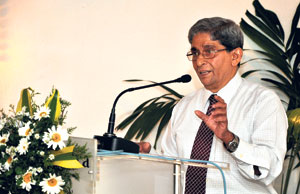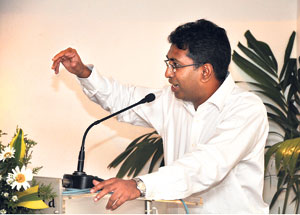There is no doubt that the main challenge facing the candidates for the post of President of Sri Lanka is the explanation of the ways and means of alleviation of poverty in the country and of raising the quality of life of all the people (irrespective of caste, creed or race).

Prof. W. D. Lakshman speaking at a discussion on the economic policies of the two presidential election candidates at the Sunday Times Business Club meeting on Tuesday. Below is Dr. Harsha de Silva, speaking at the same meeting.
Pix by Gemunu Wellage |
First how do we define poverty? The most common definition of poverty is on the basis of income.
The so called Poverty Line introduced by the Department of Census and Statistics (DCS) measures only absolute poverty; it is supposed to be based on an income level to satisfy a food energy requirement of an adult person equivalent to 2,475 to 2,750 kilo calories per day.
The expenditure by a single person as calculated on this basis by the DCS some time back was Rs. 1206 per month ( one wonders whether a person can exist at all on such an income!) and the percentage of such persons was reported to be 15.
This is surprising as about 50% of the population of the country is reported to be receiving less than the minimum kilo calorie intake of dietary energy per day and about 30% of children under five years of age are supposed to be suffering from malnutrition.
The definition of poverty on the basis of an income of $US 2 per day appears to be more reasonable. Defined on these lines the percentage of poor people in the country is reported to be around 40% of the total population.
According to the new definition of poverty formulated by the World Bank vide the World Development Report 2000/2001, poverty is better measured in dimensions such as healthcare, nutrition, safe drinking water, sanitation, household amenities, education as well as employment, income and consumption. Constructing such a composite multidimensional indicator of poverty, there are reports that the ‘highly severe poor’ districts are Moneragala, Polonnaruwa, Matale, Vavuniya and Mannar. On the basis of sectors the highest proportion of poor households, more than 80%, has been recorded in the rural sector, (which is about 70% of the population).
 The question that arises at this stage is how to alleviate such poverty? The most positive way of doing it is significantly improving real incomes (the money wage divided by the general price level) by creating employment opportunities. The other way is by introducing some sort of social security or welfare schemes such as Samurdi for those suffering from absolute poverty. The question that arises at this stage is how to alleviate such poverty? The most positive way of doing it is significantly improving real incomes (the money wage divided by the general price level) by creating employment opportunities. The other way is by introducing some sort of social security or welfare schemes such as Samurdi for those suffering from absolute poverty.
The next question is how can employment be created? (The prevailing unemployment rate by the way is supposed to be a little over 5%, though youth unemployment is reported to be as high as 21%; in addition the country must endeavour to give decent employmnt in the country itself to over a million persons mainly women employed abroad- most of whom are virtual slaves in Middle Eastern households- as well as the burdensome excess of staff in the public sector). The answer to the above question - employment is essentially created by investment especially by the private sector.
If the country is to achieve an economic growth rate of 8-10%, double its prevailing per capita income of US $ 2000 by 2020 or so and alleviate poverty significantly, the rate of investment required is estimated at about 35-40% of Gross Domestic Product (GDP) as against the investment of 25-28% of GDP per year made at present. Most of this investment will have to be of the foreign direct kind as the current national savings rate is less than 20% and since local investors cannot muster the necessary technologies and skills.
The State has to support the private sector in this effort by suitable interventions.
First, the interventions by the State include the creation of socio political stability without which the private sector will not have the confidence to invest particularly in long term projects. For this purpose it has to legislate to create good governance which encompasses the capacity of governments to manage its resources efficiently and to formulate, implement and enforce sound policies and regulations as well as the quality of the institutions and the processes they create. The word quality means not only the effectiveness of the public services or the ‘public goods’ as they are known among economists but also the transparency and accountability of public institutions.
Now let us ask how good governance is to be created in the country. Its constitution and the laws should ensure there is separation of powers among the legislature, the executive and the judiciary. This means that the institutions under the executive (particularly the public service including the Police Department) and the judiciary should be independent in the management of their affairs though being accountable to the legislature or the Parliament and the people of Sri Lanka.
This is necessary to recruit and promote such public officials solely on the basis of merit and integrity so that the services they render will be of the highest quality and are available to all the people without any partisanship and corruption; it is then that local and foreign entrepreneurs will be prompted to make long term and large investments as they will get the confidence that their (property) rights will not be in jeopardy and good law and order conditions will prevail for them to carry on their businesses without undue problems and interruptions.
Unfortunately the 1978 Constitution of this country has let the people of the country down very badly in this respect. This is why the 13th and the 17 th Amendments to the Constitution were passed unanimously in Parliament. Sadly even these amendments, though they do not meet with the treatment of communities equally and the full requirement of separation of powers, have not been made operational as at present. It is therefore unlikely that investments of the order of 35-40% of GDP per year, particularly of the foreign variety could be attracted to the country to push up annual economic growth rates to 8-10% under these conditions, which create socio- political instability.
Another kind of State intervention required to attract the magnitude of investments mentioned above is the construction of infrastructure facilities like expressways to shorten the time of travel and transport between destinations in the country considerably This has not taken place so far.
The capital expenditure incurred by the State so far in this country in such infrastructure facilities and services is woefully inadequate to meet the needs of investors and for the economy to grow at a clip of 8-10%; it has been about 5% of GDP per year . It has to be raised at least to 10% of GDP. In fact governments in East Asian countries are reported to be investing very much more in infrastructure facilities and services; in addition the private sector in these countries is also induced to participate in such investments.
In Sri Lanka private investment particularly in the setting up of schools and universities has been discouraged by the government due to some foolish theoretical considerations.
Capital expenditure has been as low as 5% mainly because of the fact that the recurrent expenditure of the government has been too high (while the revenue collection has been stubbornly low), registering budget deficits as high as 7-8% of GDP per year.
There is no doubt that the deficit has to be drastically reduced not only because of the inability to increase expenditure on infrastructure but also since it tends to push up inflation (particularly on essentials like food items), interest rates (and taxation rates) discouraging investment, debt service payments (currently reported to be beyond 90% of government revenue) and also increase the balance of payments deficit (of foreign exchange earnings over foreign exchange payments). Now the poser is, are not the candidates ballooning the budget deficit and generally throwing the economy too dangerously out of balance by their over- generous vote catching offers of salary increases and a plethora of welfare payments?
Investment also has to take place in agriculture the productivity per worker of which is as low as US$ 743 at present as against US $ 4690 in Malaysia. The poser that arises here is how can investment be increased in this vital sector that gives emploment to about 33% in the labour force? The first step is to give the ownership of land to the farmers themselves, government being the owner of about 80% of the land.
The second step is to improve productivity ( ‘more and more outputs from less and less inputs’) by increasing the scale of production by inducing the numerous small farmers to form large joint stock companies, which can undertake further processing and value addition to their primary products; further processing and value addition by these companies and other industries will help to absorb the excess labour in agriculture. Here again the necessary investments can be attracted by creating political and macro economic stability through better governance and balanced budgets with greater investment in infrastructure.
So the gist of this paper is that the candidates have to deal seriously with the posers with regard to the quantum of investment required to reduce unemployment significantly in order to alleviate the serious problem of poverty in the country. The writer’s belief is that they should in this regard emphasize mainly on measures for creating good governance and balancing the government budget.
(The writer is an economist and a consultant on Development Strategy) |


 The question that arises at this stage is how to alleviate such poverty? The most positive way of doing it is significantly improving real incomes (the money wage divided by the general price level) by creating employment opportunities. The other way is by introducing some sort of social security or welfare schemes such as Samurdi for those suffering from absolute poverty.
The question that arises at this stage is how to alleviate such poverty? The most positive way of doing it is significantly improving real incomes (the money wage divided by the general price level) by creating employment opportunities. The other way is by introducing some sort of social security or welfare schemes such as Samurdi for those suffering from absolute poverty.